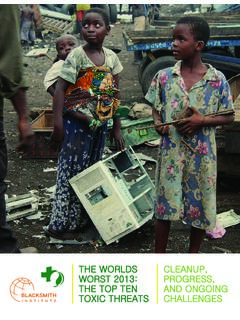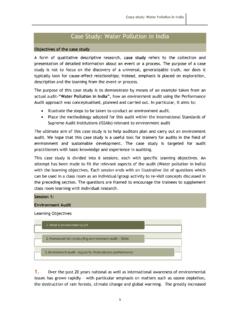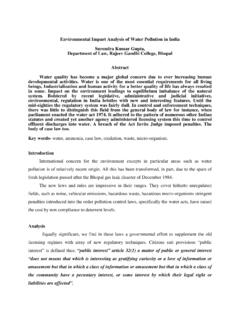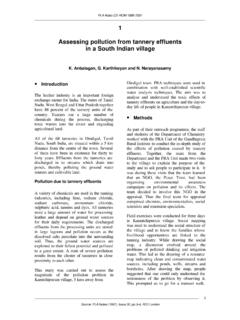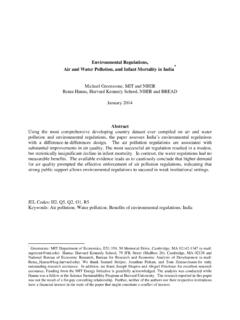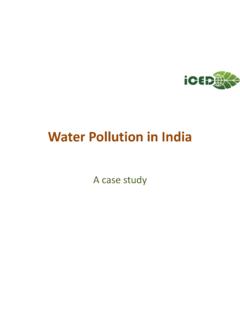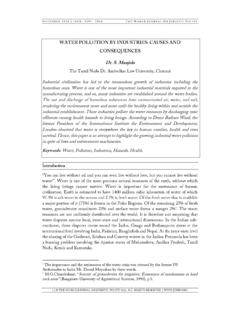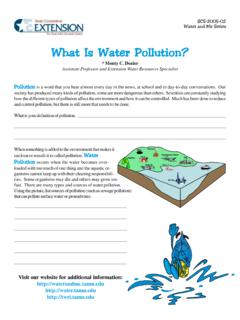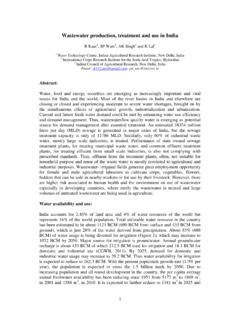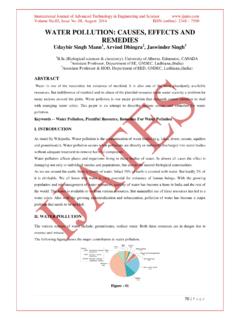Transcription of 2015World’s Worst Pollution Problems
1 The New Top Six Toxic Threats: A Priority List for RemediationWorld s Worst Pollution Problems2015 Table of ContentsThis document was prepared by Pure Earth and Green Cross Switzerland with input and review from a number of experts and volunteers, to whom we are most questions, comments, and feedback, please contact: Angela BernhardtPure Earth475 Riverside Drive, 860 New York, NY 10115+1 212 870 questions, comments, and feedback, please contact: Nathalie GysiGreen Cross SwitzerlandFabrikstrasse 178005 Zurich, Switzerland+41 (0) 43 499 13 photo:A man works in the chromium fields of Kanpur, india , an area that receives waste from, nearby tannery factories. Inhalation of chromium particles is the most common route of exposure on occupational settings. Observations documenting higher lung cancer rates in workers occupationally exposed to chromium date back to the by Sean GallagherBack cover photo:On the Indonesian island of Sulawesi, a ball mill operation uses pure mercury to facilitate gold extraction form ore.
2 The use of mercury in gold mining has been made illegal in Indonesia. However, its use continues in remote operations and as a result of existing black markets and corruption. Many industrial processes such as ASGM involve the heating of elemental mercury, resulting in the release of mercury vapors into the environment. These mercuric vapors can then settle as dust onto soil surfaces or surface water bodies through by Larry C. PriceWorld s Worst Pollution Problems 2015358 8 9 10 11 12 1617 1723 23 25 26 29 30 31 35 36 37 38 41 43 44 46 48 51 53 54 5764 Letter from Richard FullerIntroductionSection 1: Better Data Confirm the Impacts of Top PollutantsComparing Global BadsExtent of the Contaminated Site ProblemsDALYs at Contaminated SitesDALYs and This Year s ReportRevisiting the Top SixOverall Pollution BurdenSection 2: The Growing Share of Pollution -related DiseaseTransition from Communicable to ChronicSection 3: The Top Six Striving to Make ProgressIntroductionLead Used Lead-Acid Battery (ULAB) Recycling Smelting & Metal Extraction Case Example: MexicoRadionuclides Case Study: Tajikistan Uranium Mining & Radioactive Waste Disposal Mercury Case Example: Indonesia Case Example.
3 Mongolia Artisanal Small-Scale Gold Mining (ASGM) Chromium Tannery OperationsPesticides Agricultural Use Production & Storage CadmiumConclusionSection 4: Is The World Beginning to Pay Attention?3 4 World s Worst Pollution Problems 2015In 1999, I founded Blacksmith Institute in New York the result of an eventful decade of my life and a desire to make an impact on the world. At the time, very little was known about Pollution in low- and middle-income countries. Indeed part of the impetus for the organization was a simple chart on a white board; four quadrants, West and South written down the Y axis, Green and Brown across the top. West and South referred, roughly, to hemispheres; Brown and Green to environmental agendas. The chart was part of a series of retreats of sorts that I hosted at my home for like-minded people.
4 The goal of the retreats was to identify the most underserved area in the environmental movement and determine a way to address that gap. In each quadrant, we listed organizations that worked in that area World Wildlife Federation, Conservation International, Save the Whales all impressive organizations engaged in powerful, transformative work. When we were done filling in the names of every organization we could think of, we looked back at the board. Staring back at us was the bottom right quadrant: Brown/ South. We could think of no organization, government or otherwise working in this area. I drew a big X in the quadrant and wrapped my knuckles on the board. This space has a big fat zero. We ll make our impact here. Since that fateful series of retreats at my home, much has changed about our organization.
5 Rather than being run by volunteers, we now have dozens of paid professionals working out of offices in New York, London, New Delhi, Jakarta, and many other cities around the world. We have developed an impressive portfolio of projects, impacting the lives of millions of people. We have changed our name to the more descriptive Pure Earth. And importantly, we have helped identify and single out a silent killer, Pollution . Indeed, we now know that Pollution accounts for 1 in every 7 deaths in low- and middle-income countries. Each year, with our partner Green Cross Switzerland, we release a report on Pollution and health. This series, The World s Worst Pollution Problems , has been reported on widely from the New York Times to National Geographic and the Times of india . It has been downloaded thousands of times from our servers.
6 In this way, it has made a significant impact on the public s awareness of the issue. This year we report on six pollutants that pose an outsized threat to human health. The pollutants Lead, Radionuclides, Mercury, Hexavalent Chromium, Pesticides and Cadmium collectively affect the health of 95 million people and account for over million Disability Adjusted Life Years in low and middle-income countries. These pollutants result in debilitating, life-threatening diseases, particularly in children. We also report on some important advances in the Pollution management area. The World Bank has launched the Pollution Management and Environmental Health program (PMEH) to focus on water , air and soil Pollution . We expect to see some good results here. Elsewhere, UNEP has spearheaded the Minamata Convention on Mercury.
7 The convention will prohibit new mercury mines and phase out existing mines by signatory countries. Finally, The Global Alliance on Health and Pollution (GAHP) has formed a special Commission on this issue. We report on this progress in special sections in the hope you find this document useful and informative. We also hope you ll join us in working on this important , Richard FullerPresident, Pure EarthCo-chair, Global Commission on Pollution Health & DevelopmentPollution accounts for 1 in every 7 deaths in low- and middle-income countries. The Top Six Toxic Threats outlined in this report collectively affect the health of 95 million from Richard Fuller5 6 World s Worst Pollution Problems 2015middle-income countries. These pollutants result in debilitating, life-threatening diseases and death.
8 The pollutants, which were highlighted in 2010, still clearly stand out among the others around the world. These affect more people at more sites at a greater dose than other pollutants. Their toxicological profiles are well defined and severe. In almost all cases, affordable interventions exist to mitigate the Worst exposures from sites exhibiting these contaminants. There is one change in this year s top list: cadmium replaces year s report also examines how advances in data gathering and analysis on the scope and impact of Pollution , improve our understanding of the scale of these toxic threats. The 2012 Worst Polluted report established the first set of figures for the health burden of toxic Pollution at contaminated sites, by estimating for this Pollution the basic parameter developed by the World Health Organization for assessing the Global Burden of Disease the Disability Adjusted Life Year or DALY.
9 In the years since then, these DALY estimates have been expanded and refined, resulting in broad acceptance by the international health community of this evidence of the impacts of toxic pollutants. Similar DALY estimates are now available for other forms of Pollution , demonstrating the extent of overall damage caused by multiple substances. In this context, the number of people exposed to dangerous levels of Pollution is increasing, with an estimated 1 in 7 deaths in 2012 resulting from exposure to soil, water , air and/or chemical Pollution . The 2015 World s Worst Pollution Problems report is the tenth in an annual series published by Green Cross Switzerland and Pure Earth (formerly Blacksmith Institute). Over the past decade, this series identified and drew attention to the Worst , and most dangerously polluted places on the planet, while documenting and quantifying the startling health and human impacts of this neglected problem .
10 The World s Worst series of reports has effectively raised global awareness about the extent and impacts of toxic Pollution in low-and middle-income countries. Last year s report looked at the Top Ten Countries Turning the Corner on Toxic Pollution profiling countries and projects making significant strides in saving lives, improving human health and restoring environments. Their successes were the result of perseverance by champions inside government The improved data and analysis on Pollution has resulted in some changes but little has happened in terms of significant cleanup. Strikingly, as progress is made on some of the classic communicable diseases in developing countries (malaria, HIV, Tuberculosis), the proportion of the overall burden of disease attributable to toxic threats is increasing.

